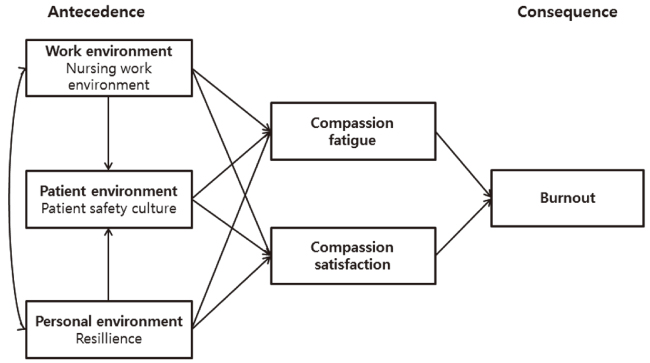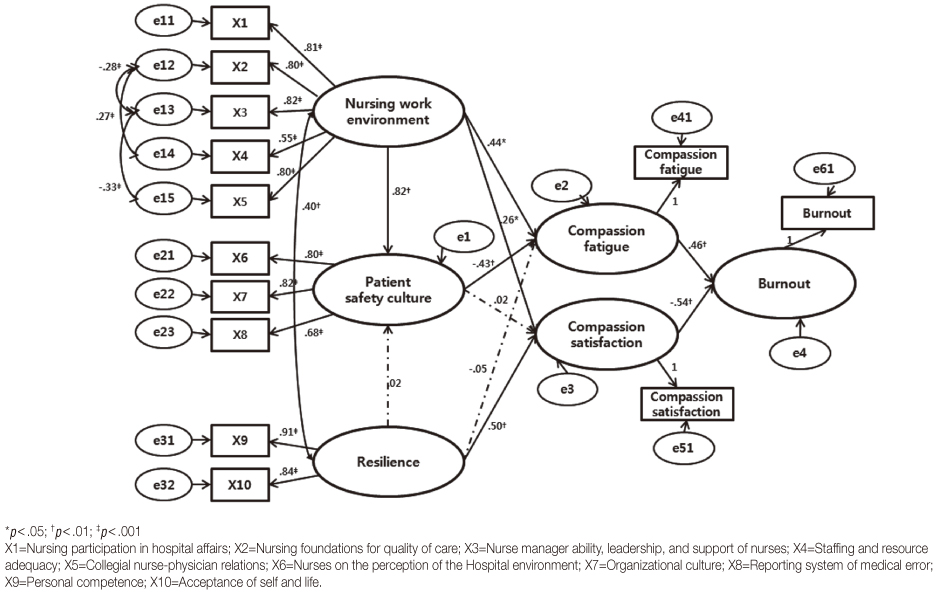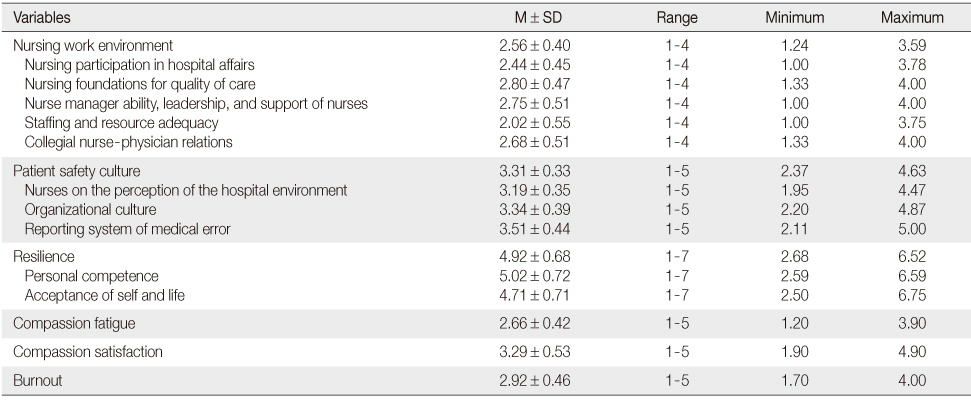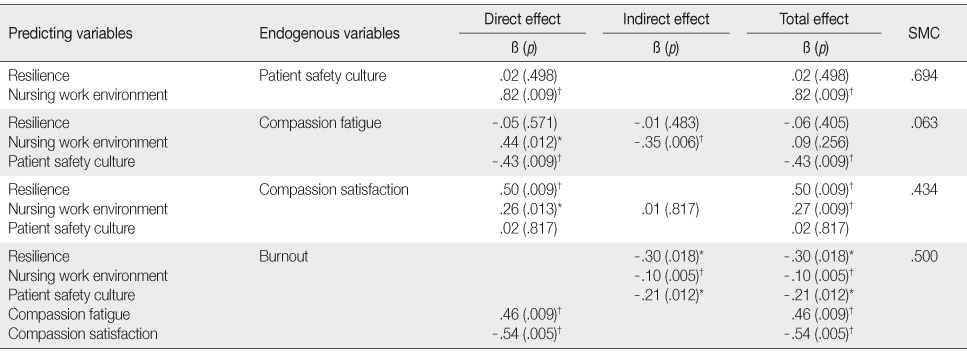Articles
- Page Path
- HOME > J Korean Acad Nurs > Volume 44(3); 2014 > Article
-
Original Article
- Structural Equation Modeling on Burnout in Clinical Nurses based on CS-CF Model
- Hyun-Jung Kim, Young-Hee Yom
-
Journal of Korean Academy of Nursing 2014;44(3):259-269.
DOI: https://doi.org/10.4040/jkan.2014.44.3.259
Published online: June 30, 2014
1Department of Nursing, Daewon University College, Jechon, Graduate School, Chung-Ang University, Seoul, Korea.
2Red Cross College of Nursing, Chung-Ang University, Seoul, Korea.
- Address reprint requests to: Yom, Young-Hee. Red Cross College of Nursing, Chung-Ang University, 224-1 Heukseok-dong, Dongjak-gu, Chung-Ang University, Seoul 156-755, Korea. Tel: +82-2-820-5700, Fax: +82-2-824-7691, yhyom@cau.ac.kr
© 2014 Korean Society of Nursing Science
This is an Open Access article distributed under the terms of the Creative Commons Attribution NoDerivs License. (http://creativecommons.org/licenses/by-nd/4.0/) If the original work is properly cited and retained without any modification or reproduction, it can be used and re-distributed in any format and medium.
Abstract
-
Purpose
- The purpose of this study was to construct and test a structural equation modeling on burnout of clinical nurses based on CS-CF model.
-
Methods
- A survey using a structured questionnaire was conducted with 557 clinical nurses. Data were analyzed using structural equation modeling.
-
Results
- The modified hypothetical model yielded the following χ2=289.70, p<.001, RMSEA=.09, GFI=.93, TLI=.91, CFI=.94, PCFI=.65, AIC=363.21, SRMR=.05 or less and showed good fit indices. Nursing work environment, patient safety culture and resilience showed indirect effects on burnout while compassion fatigue and compassion satisfaction had direct effects.
-
Conclusion
- Results of this study suggest that compassion fatigue must be decreased and compassion satisfaction has to be increased, while burnout is lowered by enhancing the clinical nursing work environment, patient safety culture and resilience. In addition, more variables and longitudinal studies are necessary to validate the clear cause-and-effect relationship between the relevant variables.
This manuscript is based on a part of the first author's doctoral dissertation from Chung-Ang University.
- 1. Park HS, Kim KN. Factors affecting burnout in ICU nurses. J Korean Acad Fundam Nurs. 2010;17(3):409–418.
- 2. Yu M. Work stress, turnover intention and burnout among nurses in neonatal intensive care units. J Korean Acad Nurs Adm. 2011;17(1):115–126. http://dx.doi.org/10.11111/jkana.2011.17.1.115Article
- 3. Garrett C. The effect of nurse staffing patterns on medical errors and nurse burnout. AORN J. 2008;87(6):1191–1204. http://dx.doi.org/10.1016/j.aorn.2008.01.022ArticlePubMed
- 4. James RK, Gilliland BE. Crisis intervention strategies. 4th ed. Belmont, CA: Brooks/Cole Thomson Learning; 2001.
- 5. Joinson C. Coping with compassion fatigue. Nursing. 1992;22(4):116. Article
- 6. Figley CR. Compassion fatigue: Coping with secondary traumatic stress disorder in those who treat the traumatized. New York, NY: Brunner-Routledge; 1995.
- 7. Figley CR. Treating compassion fatigue. New York, NY: Brunner-Routledge; 2002.
- 8. Stamm BH. Measuring compassion satisfaction as well as fatigue: Developmental history of the compassion fatigue and satisfaction test. In: Figley CR, editor. Treating compassion fatigue. New York, NY: Brunner-Routledge; 2002. p. 107–119.
- 9. Spence Laschinger HK, Leiter MP. The impact of nursing work environments on patient safety outcomes: The mediating role of burnout/engagement. J Nurs Adm. 2006;36(5):259–267.PubMed
- 10. Vahey DC, Aiken LH, Sloane DM, Clarke SP, Vargas D. Nurse burnout and patient satisfaction. Med Care. 2004;42:2 Suppl. II57–II66. http://dx.doi.org/10.1097/01.mlr.0000109126.50398.5aArticlePubMedPMC
- 11. Kim JE, Kang MA, An KE, Sung YH. A survey of nurses' perception of patient safety related to hospital culture and reports of medical errors. Clin Nurs Res. 2007;13(3):169–179.
- 12. Aiken LH, Clarke SP, Sloane DM, Sochalski J, Silber JH. Hospital nurse staffing and patient mortality, nurse burnout, and job dissatisfaction. JAMA. 2002;288(16):1987–1993.ArticlePubMed
- 13. June KJ, Byun SW. Nurse' burnout research throughout the past 10 years in Korea. J Korean Acad Nurs Adm. 2009;15(3):305–313.
- 14. Stam BH. The concise ProQOL manual. 2nd ed. Pocatello, ID: ProQOL.org; 2010.
- 15. Van Bogaert P, Meulemans H, Clarke S, Vermeyen K, Van de Heyning P. Hospital nurse practice environment, burnout, job outcomes and quality of care: Test of a structural equation model. J Adv Nurs. 2009;65(10):2175–2185.ArticlePubMed
- 16. Pietrantoni L, Prati G. Resilience among first responders. Afr Health Sci. 2008;8:Suppl 1. S14–S20.PubMedPMC
- 17. Huggard PK. Managing compassion fatigue: Implications for medical education [dissertation]. Auckland, NZ, The University of Auckland. 2008.
- 18. Yom YH, Kim HJ. Effects of compassion satisfaction and social support in the relationship between compassion fatigue and burnout in hospital nurses. J Korean Acad Nurs. 2012;42(6):870–878. http://dx.doi.org/10.4040/jkan.2012.42.6.870ArticlePubMed
- 19. Park HH. A structural model of nurses' patient safety management activities [dissertation]. Daejeon, Eulji University. 2013.
- 20. Burtson PL, Stichler JF. Nursing work environment and nurse caring: Relationship among motivational factors. J Adv Nurs. 2010;66(8):1819–1831. http://dx.doi.org/10.1111/j.1365-2648.2010.05336.xArticlePubMed
- 21. Lake ET. Development of the practice environment scale of the nursing work index. Res Nurs Health. 2002;25(3):176–188. http://dx.doi.org/10.1002/nur.10032ArticlePubMed
- 22. Cho E, Choi M, Kim EY, Yoo IY, Lee NJ. Construct validity and reliability of the Korean version of the practice environment scale of nursing work index for Korean nurses. J Korean Acad Nurs. 2011;41(3):325–332. http://dx.doi.org/10.4040/jkan.2011.41.3.325ArticlePubMed
- 23. Wagnild GM, Young HM. Development and psychometric evaluation of the Resilience scale. J Nurs Meas. 1993;1(2):165–178.PubMed
- 24. Friese CR, Lake ET, Aiken LH, Silber JH, Sochalski J. Hospital nurse practice environments and outcomes for surgical oncology patients. Health Serv Res. 2008;43(4):1145–1163. http://dx.doi.org/10.1111/j.1475-6773.2007.00825.xArticlePubMedPMC
- 25. Kanai-Pak M, Aiken LH, Sloane DM, Poghosyan L. Poor work environments and nurse inexperience are associated with burnout, job dissatisfaction and quality deficits in Japanese hospitals. J Clin Nurs. 2008;17(24):3324–3329. http://dx.doi.org/10.1111/j.1365-2702.2008.02639.xArticlePubMedPMC
- 26. Kim HY, Kim HS. Effects of perceived patient safety culture on safety nursing activities in the general hospital nurse's. J Korean Acad Nurs Adm. 2011;17(4):413–422. http://dx.doi.org/10.11111/jkana.2011.17.4.413Article
- 27. Jang YM. Coping strategies, compassion fatigue and compassion satisfaction among nurses in emergency room [master's thesis]. Daejeon, Eulji University. 2014.
- 28. Lee GS, Yom YH. Structural equation modeling on life-world integration in people with severe burns. Asian Nurs Res. 2013;7(3):112–119.Article
- 29. Epp K. Burnout in critical care nurses: A literature review. Dynamics. 2012;23(4):25–31.PubMed
REFERENCES
Figure & Data
REFERENCES
Citations

- Paediatric nurses' burnout, quality of life and perceived patient adverse events during the COVID‐19 pandemic: Testing an integrated model using structural equation modelling
Haitham Khatatbeh, Tariq Al‐Dwaikat, Jehad Rababah, András Oláh, Annamária Pakai
Journal of Clinical Nursing.2024; 33(1): 255. CrossRef - An Exploratory Study of Psychological Distress, Professional Quality of Life, Effort-Reward Imbalance, and Turnover Intention of Hospital Nurses during the COVID-19 Pandemic
Suk-Jung Han, Soon-Youl Lee, Sie-Eun Kim
Healthcare.2023; 11(19): 2695. CrossRef - Effects of Job Stress, Social Support, and Infection Control Fatigue on Professional Quality of Life among Nurses in Designated COVID-19 Hospitals
Minyoung Shin, Woojoung Joung
Journal of Korean Academy of Nursing Administration.2023; 29(5): 603. CrossRef - The Relationship Between Coping Strategies, Compassion Satisfaction, and Compassion Fatigue During the COVID-19 Pandemic
Ebtsam Aly Abou Hashish, Amal Diab Ghanem Atalla
SAGE Open Nursing.2023;[Epub] CrossRef - The relationship between secondary traumatic stress and burnout in critical care nurses: The mediating effect of resilience
Yun Jeong Jeong, Sujin Shin
Intensive and Critical Care Nursing.2023; 74: 103327. CrossRef - Effects of Clinical Nurses' Responses to Violence on Burnout: The Moderating Role of Positive Psychological Capital
Haejun Choi, Sujin Shin, Seungji Kim, Sungran Kim
Korean Journal of Adult Nursing.2023; 35(4): 406. CrossRef - Influence of the subfactors of self‐compassion on burnout among hospital nurses: A cross‐sectional study in South Korea
Mi Heui Jang, Yoo Mi Jeong, Geuna Park
Journal of Nursing Management.2022; 30(4): 993. CrossRef - Developing a structural equation model from Grandey's emotional regulation model to measure nurses' emotional labor, job satisfaction, and job performance
Won Ju Hwang, Eun Hee Park
Applied Nursing Research.2022; 64: 151557. CrossRef - Influence of Emotional Intelligence and Professional Self-concept on Compassion Competence in Psychiatric Nurses
Hye Suk Im, Won Hee Jun
Journal of Korean Academy of Nursing Administration.2021; 27(4): 259. CrossRef - A Path Model for Burnout in Community Mental Health Professionals
Jin-Joo Chang, Sung-Hee Shin
International Journal of Environmental Research and Public Health.2021; 18(18): 9763. CrossRef - Effect of Nurse's Character for Care and Sense of Coherence on Professional Quality of Life Among Oncology Nurses
Gie-Ok Noh, Gyeonga Kang, In Gak Kwon, Sang Hee Kim, Yoon Jung Kim, Jeong Hye Kim, Eun Young Park, Jeong-Sook Park, Han Jong Park, Kwuy-Im Jung
Asian Oncology Nursing.2021; 21(1): 52. CrossRef - Factors Affecting Burnout among Tertiary Hospital Nurses during the COVID-19 Outbreak
Geun-Hee Kim, Jun Ok You, Mira Lee, Yunju Choi, Yoon Mi Lee, Ji Hye Shin
Journal of Korean Academy of psychiatric and Mental Health Nursing.2021; 30(4): 390. CrossRef - The Influence of Burnout on Patient Safety Management Activities of Shift Nurses: The Mediating Effect of Compassion Satisfaction
I Seul Ryu, JaeLan Shim
International Journal of Environmental Research and Public Health.2021; 18(22): 12210. CrossRef - Association between nursing work environment and compassion satisfaction among clinical nurses
Jihyun Baek, Hyeonmi Cho, Kihye Han, Haeyoung Lee
Journal of Nursing Management.2020; 28(2): 368. CrossRef - Analysis of Research on Compassion Satisfaction among Nurses
Soon-Neum Lee, Jung-A Kim
Journal of the Korea Academia-Industrial cooperation Society.2016; 17(9): 599. CrossRef - Perceptions of Medical Personnel toward Burnout using Q Methodology
Eun Ja Yeun, Young Mi Kwon, Young Mi Lee
Journal of Korean Academy of Nursing Administration.2016; 22(1): 57. CrossRef - Effects of Nursing Practice Environment, Compassion Fatigue and Compassion Satisfaction on Burnout in Clinical Nurses
Mi Young Han, Min Sook Lee, Ju Young Bae, Young Suk Kim
Journal of Korean Academy of Nursing Administration.2015; 21(2): 193. CrossRef - Effect of Empathy, Resilience, Self-care on Compassion Fatigue in Oncology Nurses
Ho Jin Cho, Myun Sook Jung
Journal of Korean Academy of Nursing Administration.2014; 20(4): 373. CrossRef - Effects of Work Stress, Compassion Fatigue, and Compassion Satisfaction on Burnout in Clinical Nurses
Jung-Min Lee, Young-Hee Yom
Journal of Korean Academy of Nursing Administration.2013; 19(5): 689. CrossRef


Figure 1
Figure 2
Descriptive Statistics of Study Variable (N=557)
Parameter Estimates and SMC of Modified Structural Model
CR=Critical ratio; SMC=Squared multiple correlation.
Effect of Predictor Variables in the Modified Model
*p<.05; †p<.01; β=Standardized regression coefficients; SMC=Squared multiple correlation.
CR=Critical ratio; SMC=Squared multiple correlation.
*
 KSNS
KSNS
 E-SUBMISSION
E-SUBMISSION





 Cite
Cite

